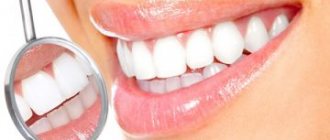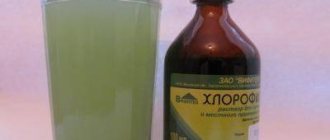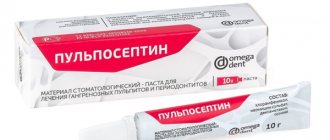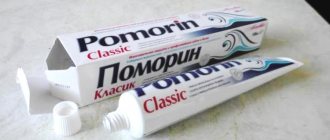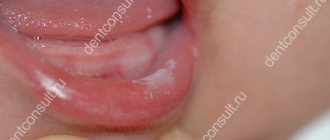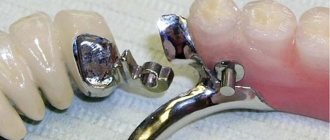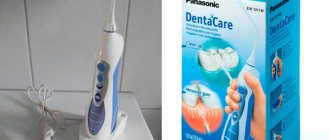3985
Pulpitis is diagnosed in a third of all patients who visit dentists. Most often, its treatment ends with pulpectomy - complete removal of the pulp and obturation of the canals.
The biological (vital) method of treatment (pulpotomy) is used much less frequently. Although, based on its merits, it deserves much more attention from dentists.
Composition and release form
The product is available in powder and liquid form, 30 g and 15 ml, respectively. The substances included in Pulpotec promote the effective treatment of temporary and permanent molars, aseptic healing of the internal soft tissues of the tooth with maximum preservation of its root structure.
The effect of the drug makes it possible to minimize the risk of complications characteristic of total pulpotomy.
The main active ingredients of the powder part of the drug:
- Zinc oxide (concentration up to 100%).
- Iodoform.
- Polyoxymethylene.
The liquid contains the following substances:
- Formaldehyde.
- Phenol.
- Dexamethasone acetate.
- Guaiacol.
- Auxiliary components.
WARNING:
Do not use Pulpotec during pulp extraction. Avoid contact of the material with soft tissues. In case of contact, rinse thoroughly with running water. Contains formaldehyde and polyoxymethylene. Toxic if inhaled and swallowed. May cause irritation, burning or hypersensitivity upon direct contact with skin. In case of contact with eyes, rinse with running water and consult a doctor.
Storage : Store at a temperature of 5-30 ◦C, avoid direct light.
Made in Switzerland.
Packaging : in 2 bottles: 15 g of powder and 15 ml of liquid.
General concept of drug effects
Pulpotec is used for diseases of the pulp of both temporary and permanent molars. When using the medicine, the following happens:
- the pulp of the inflamed crown is removed;
- the bleeding stops (press cotton balls for a few minutes);
- the drug is introduced into the pulp chamber;
- the dental cavity is temporarily filled;
- after 8-10 days, temporary cement and remaining medication are removed;
- a denser ball of medication is introduced into the tooth cavity;
- install a permanent filling.
The effectiveness of the medicine is time-tested. After its use, pain disappears in 80-85% of cases.
NOTE:
Teeth treated with Pulpotec and covered with non-removable orthopedic structures (crowns or bridges) may show pain after several months (from 3 to 1 year), despite the absence of radiological signs of damage. They usually disappear after correction of the bite height.
To successfully perform a pulpotomy procedure with Pulpotec:
- Pulpotomy is a simple operation, but it must be performed flawlessly: the cutting must be done clearly and quickly to avoid rupture of the root pulp endings and isolation of the entire intracavitary pulp.
- the treatment applies only to vital molars (study all the indications in the annotation and be guided only by them).
- The seal isolating Pulpotec must be made absolutely hermetically to avoid leakage of the drug.
Indications and contraindications for use
Pulpotek is used for:
- carrying out vital pulpotomy of permanent teeth in adult patients, including those cases when subsequent prosthetics are necessary (installation of a crown or bridge);
- pulpitis of vital non-permanent teeth in children;
- treatment of calcified root canals in elderly patients;
- restoration of molars whose roots have not yet fully formed;
- treatment of infected non-permanent molars by pulpectomy, including in the presence of inflammation (in this case, the medication is not administered into the canals of temporary teeth in children).
The drug has found wide application in pediatric dental practice.
The drug is not recommended for use in the following cases:
- the patient exhibits hypersensitivity to the components of the drug;
- the patient suffers from chronic diseases (diabetes, kidney inflammation, leukemia, etc.)
- with diffuse type pulpitis.
General information
The tooth “lives” peacefully; there is no concern about tooth pain at any time. The drug does not stain tooth tissue and does not contain harmful toxic elements.
In addition, Pulpotek helps to avoid all sorts of difficulties after therapy. The drug does not contain eugenol, for this reason it is assumed that various materials that are intended for dental restoration will be fixed.
Composition of the product and release form
The liquid consistency contains hydroxybenzene, formaldehyde, guaiacol (a substance of the phenolic class), dexamethasone acetate and other ingredients in addition.
Release form:
- thirty gram packaging - powder;
- capacity fifteen milliliters - in liquid form.
The therapeutic nature of the drug is guaranteed due to:
- analgesic effect;
- anti-inflammatory;
- mummifying.
The latter property extends to a small area of the pulp that is in direct contact with the product. The apical region continues to have full viability. The hermetic characteristics of the pulp do not change.
"Pulpotek" is used for diseases of the pulp of any molars:
— the pulp of the inflamed crown is eliminated;
- stop bleeding (apply a cotton pad for a short period);
— the product is placed in the pulp chamber;
- installing a temporary filling;
- after eight to ten days, remove the temporary cement and the remainder of the drug;
— a larger compacted ball with medicine is placed into the body of the tooth;
— installation of permanent filling material is carried out.
The results of the drug have stood the test of time. After using it, pain goes away in eighty to eighty-five percent of cases.
Indications
— implementation of vital pulpotomy of permanent teeth in adult clients, not excluding prosthetics in the future;
- in childhood, pulpitis of vital milk teeth;
— in elderly people, treatment of calcified root canals;
— restoration of molars with unformed roots;
- therapy of affected primary molars by pulpectomy, even with obvious inflammatory conditions (then the medicine is not injected into the tubules of primary teeth in children).
Contraindications
— obvious hypersensitivity to the ingredients of the drug in the client;
— the presence of chronic diseases (diabetes mellitus, inflammatory process in the kidneys, leukemia, etc.);
- diffuse type of pulpitis.
Methods of use
Partial devitalization of the pulp with the help of Pulpotec is in many ways similar to the complete devitalization of teeth, carried out with arsenic and paraformaldehyde preparations:
- Local anesthesia is administered in a manner determined by the clinical situation.
- The carious cavity is prepared using a diamond drill of the required size and shape. It is advisable to immediately prepare the crown part of the tooth for subsequent restoration.
- The pulpous chamber is opened and processed. The inflamed portion of the pulp is removed using a high-speed bur and/or laser. Access to root canals is provided.
- Antiseptic treatment of the tooth cavity is carried out with chlorhexidine, sodium hypochloride, dimexide or other antiseptic.
It is advisable to repeat the treatment 2-3 times. If there is no bleeding (a small amount of blood is acceptable), the pulp chamber is dried with an air stream. - Pulpotec is introduced into the tooth cavity. This can be done in two ways – standard and alternative; their differences are described below.
- A temporary filling is applied. A break of about 7 hours is taken to allow the paste to harden.
At the next visit, the tooth is filled and restored with permanent material. It can be applied on top of Pulpotec or on a layer of temporary cement.
For children
Treatment of pulpitis of temporary and permanent molars. In the first case, the use of the drug allows you to stop the inflammatory process in the dental pulp, remove pain and wait for the natural replacement of milk teeth with permanent elements of the jaw row.
When treating permanent molars, it is possible to complete the formation of dental roots.
For adults
- Treatment of pulpitis of permanent molars.
- Preparation of lateral chewing teeth for the installation of bridges and crowns.
- Treatment of teeth with obliterated, difficult to pass canals.
Contraindications:
- Hypersensitivity to the components of the product.
- Serious systemic diseases (leukemia, renal failure, diabetes, etc.).
- Diffuse pulpitis (spread of inflammation to the entire pulp, not only the coronal, but also the root).
- Resorption of more than half of the tooth root.
Standard
With the classic method, the doctor mixes the powdered component of the drug with liquid until a homogeneous paste without inclusions is obtained, and places a small ball of the drug inside the chamber.
If a small amount of blood is released during the process, it does not affect the effectiveness of the effect. The oral cavity itself is first dried, and after applying the material, a temporary filling is placed on the tooth.
To ensure that the drug adheres securely to the mouth of the canal and its walls, the doctor places a cotton wool roll between the patient’s teeth. When he bites it, the paste comes into close contact with the walls of the cavity, as a result of which the most effective treatment is ensured.
Alternative
The dentist may also apply the composition in another way. The product is mixed to a homogeneous consistency on a laboratory glass slide, then a ball is formed from the resulting medium-hard paste and placed in a chamber.
Then the product is pressed mechanically to ensure contact with all surfaces of the internal cavity, and a temporary filling is placed.
Polymerization requires about 7 hours; during the second visit to the doctor, the specialist uses dental cement to install a permanent filling. It can be performed directly on the drug bead.
Some specialists leave a small layer of temporary cement to isolate the main filling from Pulpotek.
Note:
Teeth treated with Pulpotec and covered with non-removable orthopedic structures (crowns or bridges) may show pain after several months (from 3 to 1 year), despite the absence of radiological signs of damage. They usually disappear after correction of the bite height.
To successfully perform a pulpotomy procedure with Pulpotec:
- Pulpotomy is a simple operation, but it must be performed flawlessly: the cutting must be done clearly and quickly to avoid rupture of the root pulp endings and isolation of the entire intracavitary pulp.
- the treatment applies only to vital molars (study all the indications in the annotation and be guided only by them).
- The seal isolating Pulpotec must be made absolutely hermetically to avoid leakage of the drug.
Warning:
Do not use Pulpotec during pulp extraction. Avoid contact of the material with soft tissues. In case of contact, rinse thoroughly with running water. Contains formaldehyde and polyoxymethylene. Toxic if inhaled and swallowed. May cause irritation, burning or hypersensitivity upon direct contact with skin. In case of contact with eyes, rinse with running water and consult a doctor.
Storage : Store at a temperature of 5-30 ◦C, avoid direct light.
Made in Switzerland.
Packaging : in 2 bottles: 15 g of powder and 15 ml of liquid.
Price: $65.
Analogues: Formocresol, Pulpodent.
Methodologies for using the product
The use of the drug is appropriate in the case of classical pulpotomy or using a laser. Polymerization occurs within six to seven hours.
The classic type of pulpotomy involves mixing the drug in powder and liquid to a paste-like consistency. Next, the resulting cream-medicine is introduced into the pulp chamber using a channel filler. To ensure a tight fit to the mouth of the canal and its sides, a cotton swab is placed between the jaws, and the client bites it until the preparation is completely adapted. Then a temporary filling is installed.
An alternative is to mix the powder and liquid to form a paste on a glass surface and roll into a compact ball. Putty pea formations are placed in the pulp chamber and clamped with a tool or cotton wool. After waiting for the drug to harden, install the filling temporarily.
At the next visit, the dentist will perform restoration with composite materials directly on Pulpotek or with isolation using a spacer.
The use of the medicine requires caution. In case of contact with soft tissues, it will need to be thoroughly rinsed with water. Do not inhale or swallow - the product is very toxic.
Storage is recommended in a dark place at temperatures from five to thirty degrees Celsius.
Side effects. Mostly, clients do not notice the negative effects from Pulpotek.
It is worth paying attention if:
— there is mild pain, which can be eliminated at the next consultation with the dentist (the pain is pacified by adding a new portion of the product after eliminating the original one and placing a temporary filling);
- episodic arthritic pain, relieved with medication;
- acute form of pain is observed very rarely.
STORAGE CONDITIONS
Store in a dry place, protected from direct sunlight, in a tightly closed container, at a temperature from +5°C to +25°C.
Shelf life – 3 years.
Failure to comply with storage conditions leads to changes in the performance characteristics of the material and a reduction in its shelf life.
The manufacturer is not responsible for loss of product quality caused by non-compliance with the conditions of transportation, storage and use established by the manufacturer for these products.
Responsibility for using the material for purposes other than those specified by the manufacturer rests with the user.
Side effects
The medicine is well tolerated by patients. Often the drug does not cause pain, however, in some cases the following undesirable reactions may occur:
- mild pain, which, as a rule, goes away after a subsequent visit to the dentist (pain relief is carried out by introducing a new portion of material after removing the primary and installing a temporary filling);
- periodic arthritic pain that goes away after the inflammation is relieved with medications;
- acute pain is extremely rare (1:1000), the cause of sharp pain may be the treatment of a non-viable molar, or failure to detect a perforation of the cavity wall or a fracture of the dental crown (in this situation, temporary material is removed, a diagnosis is made and treatment is performed with a pulpectomy or the tooth is removed) .
2 METHODS OF APPLICATION OF PULPOTEK ARE RECOMMENDED:
1). Traditional method: Mix Pulpotec liquid with Pulpotec powder to form a smooth, creamy paste. Add the paste to the pulp chamber using a paste filler. The presence of a small amount of blood will not affect the effectiveness of the material.
Dry the cavity immediately before adding the paste. Close the cavity with temporary cement, for example: Temporary cement in paste “PD”. In order to ensure a good fit of the paste to the walls of the canal and the mouth, place a cotton roller between the upper and lower molars, ask the patient to bite the roller, first lightly, then hard, so that the paste closely adapts to the walls of the pulp chamber and the mouth of the root canal.
2). Another method of application : mix the powder and liquid on a glass slide to the size of a small putty ball and place directly into the pulp chamber. Press with a tool and finish as described above with temporary cement and a cotton roll. The polymerization time of Pulpotec is about 7 hours.
At the second visit, the treatment is completed with the placement of a permanent restoration, which can be installed directly on Pulpotec.
You can leave a thin intermediate layer of temporary cement to isolate Pulpotek from the filling material. Possible side effects: In most cases, treatment with Pulpotec is painless. However, there may be cases of pain before a return visit in the following situations:
- Moderate pain lasts until the second visit. To stop it, you should remove the entire primary portion of the material, add a fresh portion and perform a temporary filling.
- Recurrent arthritic pain. Treated with anti-inflammatory treatment.
- In approximately 1 case in 1000, acute pain occurs as a result of: - treatment of an initially non-viable tooth; — undiagnosed fracture of the tooth crown or perforation of the cavity wall.
In this case, after removing the temporary cement, an accurate diagnosis should be established and appropriate treatment should be carried out either by pulpectomy or tooth extraction if necessary.
Precautionary measures
The drug cannot be used when performing pulp extraction. After mixing, the material should not come into contact with soft tissues and mucous surfaces of the oral cavity. If it gets on the inside of your cheeks or tongue, rinse your mouth with clean water.
The product contains formaldehyde, therefore, mild or moderate poisoning
If the product comes into contact with the skin, it causes redness, itching, burning and sensitivity, so in this case you need to wash off the drug.
If the product gets into your eyes, rinse with plain water and immediately contact a specialist.
In order for the procedure to be carried out as efficiently and painlessly as possible, you must also take into account the following recommendations:
- Cutting off the affected part of the pulp is carried out quickly and carefully so that the ends of the root segment do not rupture and the intracavity area does not become isolated.
- Treatment using the drug is allowed only for vital molars.
- When filling, whether it is a temporary or permanent procedure, it is necessary to ensure that the cement ensures maximum tightness of the cavity.
If cracks or gaps remain, saliva, food, and liquid will get inside. This leads to disruption of the condition of the pulp, can provoke re-infection and increase the risk of toxic effects of the drug on the body.
Reviews
The results of vital extirpation largely depend on the qualifications of the doctor. It is necessary to be able to accurately determine the area of spread of the inflamed pulp in order to minimally affect the healthy part.
If you or your child have undergone partial devitalization of teeth, share your impressions about it with our specialists and patients, leave your comment at the bottom of this page.
If you find an error, please select a piece of text and press Ctrl+Enter.
Tags medications pulpitis
Did you like the article? stay tuned
Previous article
Basics of tooth restoration with Glassix fiberglass pin
Next article
In what cases is a disconnecting mouthguard used and the mechanism of action of the device?
Analogues and prices
The cost of one of the components of the drug varies from 1,700 to 2,500 rubles, depending on the city and the specific pharmacy.
The price of a set consisting of a portion of powder and a bottle of liquid is 4-4.5 thousand.
The drug has several analogues of both Russian and foreign origin:
- Pulpodent. This Russian drug, available in the form of a powder with liquid, provides an analgesic effect, relieves inflammation and mummifies the pulp.
The shelf life, like the product in question, is 3 years, the cost varies between 700-1000 rubles. - Formocresol. This is a foreign analogue that contains cresol in a consistency of 35% and formaldehyde 19%; when exposed to it, it leads to mummification of the pulp in the molar root (in whole or in part depending on the duration of treatment).
The product costs 190-250 rubles, but it is difficult to find for sale in Russian pharmacies. - Instillagel. The composition includes lidocaine hydrochloride, chlorhexidine gluconate, water, propylene glycol and a number of excipients.
The product provides disinfecting, anti-inflammatory and mummifying effects, shelf life - 5 years. A 6 ml syringe costs about 1100-1500 rubles.
Pulpodent - instructions
Treatment of pulpitis using the vital amputation method is carried out in two visits.
On the first visit, after anesthesia and preparation of the carious cavity with a sterile bur, open the pulp chamber and amputate the coronal pulp with a sharp spherical bur.
Then carefully perform hemostasis to avoid the formation of a clot, which can prevent contact of the paste with the pulp stump and, if infected, lead to complications. After the bleeding has completely stopped, the cavity must be dried with a sterile cotton swab and the pulp stump covered with a paste obtained by mixing the powder with liquid.
To do this, on a glass plate at a temperature of 22±1°C and a humidity of 55±10%, mix 1 measuring cup (0.10-0.12 g) of powder with 2 drops of liquid (0.05-0.06 g) until a homogeneous mass is obtained. .
The paste placed on the pulp stump is covered with a temporary eugenol-free material (“Dentin powder”), which is carefully compacted to create a seal in the stump area. The amount of paste should be optimal to prevent leakage onto the gums when compacting the paste. To ensure good adhesion of the paste to the walls and mouth of the canal between the upper and lower molars, you can place a cotton roll and ask the patient to bite on the roll without much effort.
On the second visit after 8-10 days, if there is no pain and after an X-ray of the tooth confirms the success of the treatment, it is recommended to remove the temporary filling and material and add a fresh portion of Pulpodent paste of a denser consistency to the tooth cavity. Then the preparation should be isolated with eugenol-free material, the tooth crown should be restored with a composite or compomer or using glass ionomer cement.
Material stored or transported at low temperatures must be kept at room temperature for at least 1 hour before use.
Vital amputation using ferrous sulfate-based drugs in pediatric dentistry
At the present stage of development of dentistry, treatment methods that involve preserving the vitality of the pulp and restoring its functions are becoming increasingly widespread. This is especially true when treating pulpitis of primary teeth with unformed roots, when it is important to preserve the pulp to complete root growth.
Treatment of pulpitis of primary teeth in children should be timely and adequate. Temporary teeth play an important role in the formation of dentition and jaws, timely eruption and correct placement of permanent teeth, normal development of the functions of the dental system, while early removal leads to a failure of normal formation processes.
The choice of treatment method for pulpitis depends on the diagnosis of the disease, the age of the child and the possibility of establishing psychological contact with him. With the development of new technologies in dentistry, there has been a tendency to increase the frequency of use of vital treatment methods, which have a number of advantages: the number of patient visits to the dental office is reduced, and the use of drugs with a resorptive effect is eliminated. Among the vital methods, the most widely used method is vital amputation (pulpotomy), based on morphological differences in the structure of the root and coronal pulp.
When treating pulpitis of primary teeth using the vital amputation method, preparations based on 35% formocresol and 2% glutaraldehyde are used. However, according to studies, in many cases the use of these drugs was unsuccessful. There is also an opinion about the possible cytotoxic and mutagenic effects of formocresol. In this regard, there was a need to search for new, more effective drugs for the treatment of pulpitis of primary teeth. Today these are preparations based on ferrous sulfate (ViscoStat, Astringedent).
According to the literature (R.E. McDonald, D. Avery, M.S. Duggal), treatment of primary teeth using the vital amputation method using 35% formocresol was unsuccessful in approximately half of the cases: during the study period (12 months) Children in this group complained of pain in the area of the treated tooth, changes were found on the radiograph in 5-6 teeth out of 50 (destruction of bone tissue in the periapical region, in the root furcation zone). Accordingly, the percentage of successful treatment was 89%. When using ferrous sulfate preparations during the entire observation period (1 year), only in one tooth out of 50 changes were detected on the radiograph: destruction of bone tissue in the periapical region and in the root furcation zone. Accordingly, the success of endodontic treatment was 98%. Thus, the percentage of successful treatment when using ferrous sulfate preparations is much higher than when using formocresol-based preparations.
Materials and research methods
Vital pulp amputation is a method of removing inflamed and infected coronal pulp in order to preserve the vital root pulp.
The method of vital amputation consists in removing the coronal pulp, rich in cellular elements, and preserving the root pulp, which ensures the normal physiological course of the growth and development of the temporary tooth and its surrounding structures. The use of pulpotomy is based on differences in the structure of the coronal and root pulp of teeth: the coronal pulp has a looser structure due to the large number of vascular anastomoses and the presence of cellular elements. Consequently, during inflammation, more significant changes in microcirculation occur in the coronal pulp. In the root pulp there are practically no cellular elements, connective tissue fibers predominate, therefore, in the root pulp tissue swelling is less pronounced, there is no compression of blood vessels and the phenomena of congestive hyperemia. This structural feature allows amputation of the coronal pulp with subsequent preservation of the function of the viable root pulp.
Ferrous sulfate preparations used for vital amputation in primary teeth are ViscoStat and Astringedent.
ViscoStat is a viscous hemostatic gel containing 20% ferric sulfate, which has a gentle coagulating effect on soft and hard dental tissues. Hemostasis is achieved mainly due to the formation of coagulation plugs (thrombi) in the lumens of the capillaries. This product is used to stop capillary bleeding and ensures high-quality pulpotomy of primary teeth in one visit.
The effectiveness of the ViscoStat solution (Fig. 1) increases significantly when using the special Dento-Infusor device, since the effect of hemostatic agents depends on the method of their application.
Rice. 1. ViscoStat - viscous, containing 20% ferric sulfate, hemostatic gel, has a gentle coagulating effect.
Using a brush at the end of the Dento-Infusor nozzle, the hemostatic is “rubbed” into the capillaries, which leads to the formation of blood clots. This also removes blood clots outside the lumens of the capillaries. This procedure protects the formed vascular blood clots from being removed when washed off.
As a result, we have a clean, dry surface.
Description of clinical observations
Clinical case: patient A. A. Frolov, 4.5 years old. He complained of pain in the area of the 74th tooth that occurred during meals. When examining 74 teeth, a carious cavity filled with softened dentin was discovered. The tooth cavity was opened at one point, touching which caused pain. The color of the tooth was not changed. Percussion is painless, the mucous membrane and the transitional fold in the projection of the roots of the causative tooth are without pathology. As a result, a diagnosis of chronic fibrous pulpitis of 74 teeth was made and treatment was carried out using the vital amputation method using ViscoStat gel according to the following scheme:
Local anesthesia: Ultracaine D-S 1.7 ml, 1:200,000.
Preparation of a carious cavity and opening of the cavity of 74 teeth. Necrotic dentin is removed from the walls and bottom of the carious cavity. It is important to carefully prepare the carious cavity before opening the pulp chamber. The cavity is then opened wide to create a direct transition into the tooth cavity. Resection of the arch of the dental cavity is carried out with a sterile bur. In temporary molars, after opening the hole with a ball-shaped bur, the overhanging edges are cut off with a cylindrical bur. This manipulation requires the doctor to know the topography of the pulp chamber in order to prevent perforation and provide direct access to the orifices of the root canals. Antiseptic treatment (chlorhexidine bigluconate 0.05%).
Removal of coronal pulp (pulpotomy) using a ball bur at low speed. Next, the mouths of the root canals are processed, forming additional platforms to relieve excess pressure from the root pulp. Then a deep pulpotomy is performed with a sterile carbide bur on an extended stem (Fig. 2).
Rice. 2. Pulpotomy was performed.
Using the Dento-Infusor tip, ViscoStat solution is applied to the orifice pulp. Hemostasis is achieved within 10-30 seconds.
During the process of rubbing the solution, additional water is sprayed so that coagulation clots do not stick to the treated tissue. The work area is thoroughly rinsed and cleaned with a saliva ejector. The amount of hemostatic required for one tooth is 1/3-1/2 of the volume of the tooth cavity. After the bleeding has stopped, the ostial pulp is covered with a brown scab, there is no bleeding (Fig. 3, 4).
Rice. 3. Application of ViscoStat gel to the canal orifices.
Rice. 4. Coagulated ostial pulp.
Applying a thin layer of zinc oxide eugenol cement to the treated tissue and the bottom of the pulp chamber. Next, an insulating gasket made of glass ionomer cement is made (Fig. 5).
Rice. 5. Placement of zinc oxide eugenol cement and a gasket made of glass ionomer cement on the bottom of the tooth cavity.
Carrying out tooth restoration (Fig. 6, 7).
Rice. 6. Tooth restoration.
Rice. 7. The final appearance of the restoration using photopolymer material.
Conclusion
Ferrous sulfate preparations appeared on the dental materials market relatively recently. In the course of research and clinical experiments, the physical and mechanical properties of ferrous sulfate preparations were studied, and their greater effectiveness was proven over formocresol preparations (98% and 89%) in the treatment of pulpitis of primary teeth in children using the vital amputation method.
The percentage of successful treatment with ferrous sulfate preparations is much higher than with formocresol-based preparations. The use of ferrous sulfate preparations (ViscoStat) makes it possible to quickly stop bleeding and ensure high-quality pulpotomy of primary teeth in one visit, avoiding complications and the need for repeat visits for patients.
Literature
- V. K. Leontiev, prof. L.P. Kiselnikov. Pediatric therapeutic dentistry.
National leadership. - M.: GEOTAR-Media, 2010. - Dentistry of children and adolescents /
edited by Ralph E. MacDonald, Daveig R. Avery (translation by T. V. Vinogradova). - M.: MIA, 2003. - M. S. Duggal, M. E. J. Curzon, S. A. Fail, K. J. Toumba, A. J. Robertson. Treatment and restoration of baby teeth
(translation by T. V. Vinogradova). - M.: MEDpress-inform, 2006. - L. S. Persin, V. M. Elizarova, S. V. Dyakova. Pediatric dentistry.
- Medicine, 2005. - R. Beer, M. A. Bauman, Andrei A. Kielbasa. Illustrated guide to endodontology.
- M.: MEDpress-inform, 2008. - T. V. Vinogradova. Guide to pediatric dentistry.
- Medicine, 1987. - M. V. Kuryakina .
Therapeutic dentistry for children . - M., Nizhny Novgorod: NGMA, 2001. - A. A. Kolesov. Pediatric dentistry.
- M., 1991.
A complete list of references is in the editorial office.
Features of the composition and medicinal properties
Pulpodent is available in two forms: powder and liquid, their components differ:
- Powder . It is based on polyoxymethylene as an antiseptic. The substance is capable of providing pulp devitalization, but in a partial volume. The powder also contains iodoform, which is responsible for a long-term antibacterial effect, and several other additional substances.
- Liquid . The antiseptic contained in the drug in liquid form is eugenol. Another beneficial property of this substance is its calming effect. Another element with antiseptic properties is phenol, which is responsible for maintaining the residual pulp sterile. Dexamethasone, used at a concentration of 0.13%, is a glucocorticosteroid that has an antiallergic effect and accelerates the process of relieving inflammation.
The active substances provide the drug with the following medicinal properties:
- analgesic;
- anti-inflammatory;
- mummifying.
As for the mummifying property, only a small part of the pulp is exposed to it, which is in direct contact with the drug. The apical part remains complete and viable. Pulp tightness also remains unchanged.
Application area
Pulpodent is used in the treatment of various types of pulpitis: both chronic and acute. Chronic pulpitis can occur in several forms:
- Focal . This form of the disease is characterized by severe, acute pain, often paroxysmal.
- Diffuse . This form of the disease is permanent, pain may not stop at all, only occasionally becoming less noticeable.
Acute pulpitis also has several forms:
- Fibrous . It is characterized by aching pain, which increases with rising temperature, changing weather conditions and in the event of exposure to other external irritants.
- Hypertrophic . With this form of the disease, pain appears only if the affected area is irritated.
- Gangrenous . The pain can be constant or periodically aching. A characteristic feature of this course of the disease is bad breath.
The use of the drug is effective for any course of the disorder.
Instructions for use
Before using the Pulpodent material, it must be kept at room temperature for at least 1 hour.
When using the vital amputation method, treatment using this material takes place in several stages:
- Application anesthesia is performed . Most often, a syringe with a needle of the required shape is used for this, depending on the location of the tooth.
- Then the coronal pulp is removed . After the bleeding has completely stopped, the pulp stump is covered with a mixture prepared from powder and liquid. The treated area is then covered with temporary material.
- After about a week, an x-ray is taken and if the result is positive, then the temporary material is removed and a portion of a new mixture is applied in its place.
- Then the crown of the tooth is restored .
To prepare the mixture, powder and liquid are used in a 1:2 ratio.
Cost and analogues
The average price of a package of Pulpodent material is 650-700 rubles. It contains a jar of powder and a bottle of liquid. Also
A measuring cup, dropper, and instructions should be available.
You must buy the drug in dental pharmacies or through trusted websites. The manufacturer warns against the possible purchase of a counterfeit.
The main analogue of the material is Pulpotek; its characteristics are similar to Pulpodent. The product has the same release forms and similar indications for use.
Sources:
- https://zubovv.ru/lechenie/zubyi/pulpit/instruktsiya-po-primeneniyu-pulpotek.html
- https://dentazone.ru/preparaty-oborudovanie/medicamenty/pulpotec.html
- https://www.vash-dentist.ru/lechenie/zubyi/pulpit/instruktsiya-po-primeneniyu-pulpotek.html
- https://www.uadent.com/pulpotec-lecheniya-vitalnyx-molyarov-instrukciya/
- https://www.uadent.com/pulpodent/
- https://dentazone.ru/preparaty-oborudovanie/materialy/pulpodent.html
